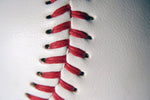
How Many Stitches Does a Baseball Have? The Surprising Answer
, by Brad Purcell, 6 min reading time

, by Brad Purcell, 6 min reading time
The game of baseball, with its rich history and tradition, has long been defined by various elements that contribute to the sport's unique identity. One such essential element is the stitching on baseballs, which plays a crucial role in determining the ball’s performance, durability, and grip.
Baseballs have undergone many changes throughout the years, but the stitching remains one of the most distinctive features, giving the ball its shape and character. Let’s dive into the art of baseball stitching and explore how many stitches are typically found on a standard baseball.
A standard baseball used in Major League Baseball has 108 double stitches, which equates to 216 individual stitches. This number isn’t random; it’s a result of generations of baseball enthusiasts refining the design to enhance performance and durability. The stitching process plays a crucial role in the aerodynamics of ball movement, affecting everything from the ball’s curve to its accuracy in flight.
Explore popular major league baseballs online
A baseball’s design is a blend of craftsmanship and functionality, with each component playing a vital role in ensuring optimal performance during every baseball game. The stitch count of 108 double stitches is integral to the ball’s structure, creating a symmetrical pattern that enhances both durability and gameplay.
Here’s a breakdown of the key components:
These elements are meticulously crafted in factories to meet the high standards of both casual and competitive play. The design and durability of baseballs, including famous baseballs used in iconic games, uphold the sport’s legacy while providing reliability across the field.
Baseball stitches are more than just decorative features on a ball; they play a crucial role in the game’s performance, durability, and overall quality. Whether it’s a regulation baseball used in Major League Baseball (MLB) or a recreational-grade baseball, baseball stitches have a significant impact on gameplay. Here’s why they matter:
One of the most important functions of baseball stitches is to provide grip for players. The double stitches create raised seams that allow pitchers to control the ball during delivery, especially for breaking pitches and curveballs. This feature of baseballs ensures accuracy during throws and helps batters get better control over their swings. The stitches guide batters in making accurate pitches, leading to more consistent play.
The craftsmanship behind baseball stitching plays a vital role in the durability of high-quality baseballs. The double stitches tightly bind the cowhide leather covers around the cork or synthetic cores of the ball. This stitching ensures that baseballs can withstand repeated impacts during games without falling apart. In Major League Baseballs, where balls are used in multiple games, durable stitches are essential to maintain the ball’s integrity across long baseball seasons.
The 108 double stitches on a baseball are meticulously designed to ensure consistency in every ball produced. Whether it’s for professional baseball leagues or casual local games, these precise stitches play a vital role in maintaining uniformity across the dozens of baseballs manufactured in factories. This consistency is essential for fair play and reliable performance, eliminating slight variations that could influence gameplay and ensuring a level playing field in every match.
The impact of baseball stitches goes beyond aesthetics. They enhance the aerodynamics of the ball, influencing ball movement in flight. The stitches contribute to ball control and curved ball flight, making it easier for pitchers to throw breaking pitches and for batters to anticipate ball behavior. Without proper stitching, balls wouldn’t perform as effectively, leading to inaccurate pitches and less predictable ball curves.
The function in baseball that stitches serve is multifaceted. Not only do they provide grip and control, but they also ensure the ball maintains its shape throughout play. The stitching on regulation baseballs helps players perform high-quality pitches and accurate swings. Additionally, hand-stitched baseballs often feature waxy thread that adds strength, making them more reliable for long-term use.
The history of baseball stitching traces back to the 19th century, when the game of baseball began to formalize its equipment. Initially, hand-stitching baseballs was the only method, and it remained standard for a long time. Over the years, computerized stitching machines have become more prominent, but hand-stitching still holds a special place, ensuring precision and durability. The art of stitching was, and still is, fundamental in creating durable baseballs for both recreational-grade baseballs and Major League Baseballs.
Over the years, innovations in baseball stitching have introduced synthetic materials and higher-grade threads, significantly enhancing the durability of baseballs throughout demanding seasons. These advancements ensure that baseballs withstand prolonged use while maintaining consistent performance.
Looking ahead, the future of baseball stitching may bring even more durable wax-coated threads, further refining the precision and reliability of every ball produced in factories. This ongoing evolution not only preserves the craftsmanship of baseball stitching but also elevates game performance, ensuring players experience the best quality on the field.
At Baseball360, we deliver top-quality baseball equipment designed to elevate every player’s performance. From reliable essentials to advanced gear, our collection includes everything you need to succeed on the field.
In addition to baseballs, our product range includes:
Whether you’re refining your pitching, perfecting your swing, or searching for durable game-day equipment, we’ve got you covered. With a focus on quality and innovation, our products are tailored for players of all levels. Explore our selection today and discover what sets us apart!


